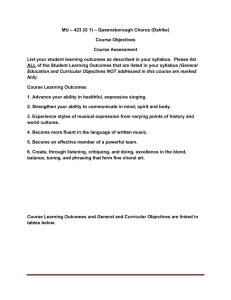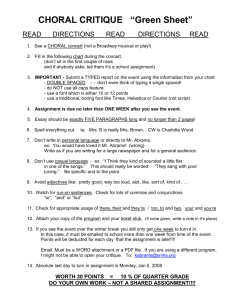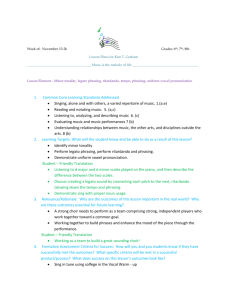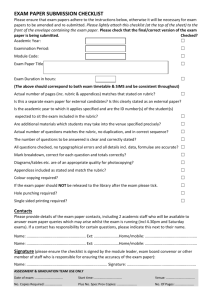MU – 413 (F 2) – Vocal Ensemble (Dahlke) Course Objectives
advertisement
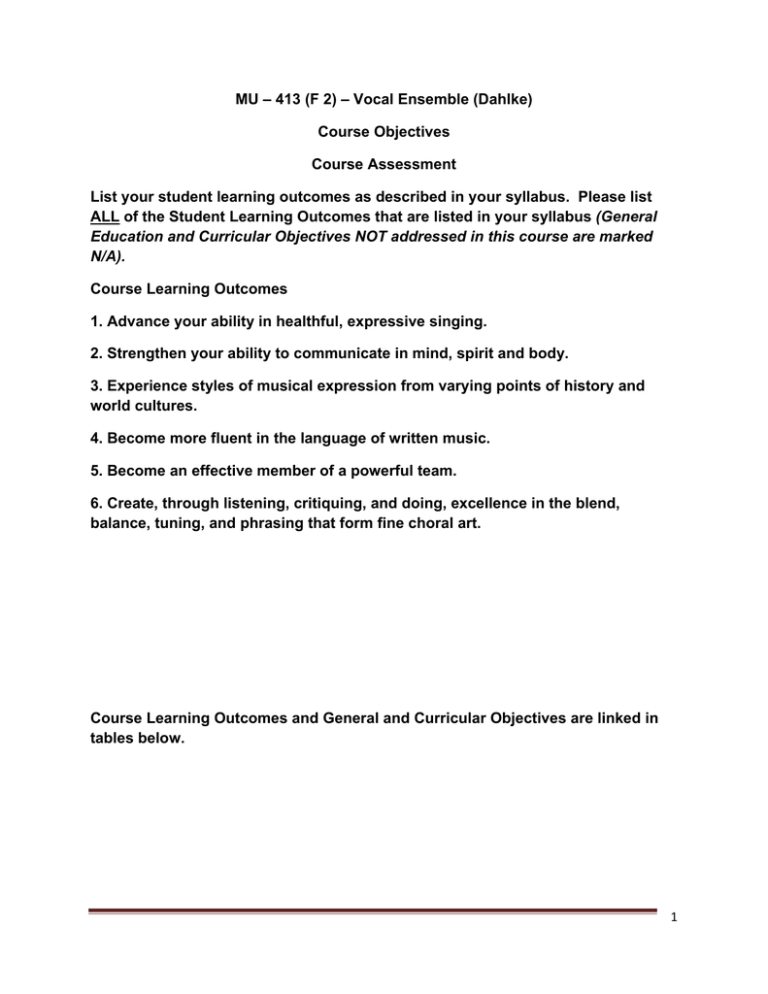
MU – 413 (F 2) – Vocal Ensemble (Dahlke) Course Objectives Course Assessment List your student learning outcomes as described in your syllabus. Please list ALL of the Student Learning Outcomes that are listed in your syllabus (General Education and Curricular Objectives NOT addressed in this course are marked N/A). Course Learning Outcomes 1. Advance your ability in healthful, expressive singing. 2. Strengthen your ability to communicate in mind, spirit and body. 3. Experience styles of musical expression from varying points of history and world cultures. 4. Become more fluent in the language of written music. 5. Become an effective member of a powerful team. 6. Create, through listening, critiquing, and doing, excellence in the blend, balance, tuning, and phrasing that form fine choral art. Course Learning Outcomes and General and Curricular Objectives are linked in tables below. 1 Gen Ed. Obj. 1. Communicate effectively through reading, writing, listening and speaking Outcome desired Learning outcome #1 Outcome desired Learning outcome #2 Outcome desired Learning outcome #3 2. use analytical reasoning to identify issues or problems and evaluate evidence in order to make informed decisions 3. reason quantitatively and mathematically as required in their fields of interest and in everyday life Outcome desired Learning outcome #5 Outcome desired Learning outcome #6 Learning outcome #5 Learning outcome #6 Learning outcome #4 4. use information management and technology skills effectively for academic research and lifelong learning N/A 5. integrate knowledge and skills in Learning outcome #1 Outcome desired Learning outcome #4 Learning outcome #2 Learning outcome #3 Learning outcome #4 Learning outcome #6 2 their program of study 6. differentiate and make informed decisions about issues based on multiple value systems 7. work collaboratively in diverse groups directed at accomplishing learning objectives 8. use historical or social sciences perspectives to examine formation of ideas, human behavior, social institutions, or social processes Learning outcome #1 Learning outcome #2 Learning outcome #3 Learning outcome #4 Learning outcome #5 Learning outcome #6 Learning outcome #5 Learning outcome #6 Learning outcome #3 9. employ N/A concepts and methods of the natural and physical sciences to make informed judgments 10. apply aesthetic and intellectual Learning outcome #1 Learning outcome #2 Learning outcome #3 Learning outcome #6 3 criteria in the evaluation or creation of works in the humanities or the arts Curricular Outcome Objectives (A- desired I); specific objectives for music concentration Outcome desired Outcome desired Outcome desired A. In praxis, students will demonstrate progressive development and competency in the technical skills requisite for artistic selfexpression in at least one major area of performance. Learning outcome #1 Learning outcome #2 Learning outcome #3 Learning outcome #4 Learning outcome #6 B. Students will demonstrate a progressive understanding of the various elements and basic interrelated processes of creation, interpretation, Learning outcome #1 Learning outcome #2 Learning outcome #3 Learning outcome #4 Learning outcome #6 4 and execution within their discipline. C. In written work, discussion, and creation of art, students will appropriately utilize the vocabulary of their respective discipline. D. Students Learning will integrate outcome theoretical #1 knowledge and performance skills in the creation and performance of collaborative and individual projects. E. In discussion and written assignments, students will observe, analyze, and critique performances of performing artists utilizing appropriate Learning outcome #3 Learning outcome #2 Learning outcome #4 Learning Learning outcome outcome #5 #6 Learning outcome #4 Learning outcome #6 Learning Learning outcome outcome #5 #6 5 jargon. F. Students will be able to place works of art and/or performances in historical and stylistic contexts and demonstrate appreciation of the cultural milieu in which they were created. G. Students will integrate personal observation and objective criticism in the evolution of their artistic work. Learning outcome #3 Learning outcome #1 Learning outcome #2 H. Students will form and defend fundamental value judgments about works of art within their major area of concentration I. Employing creative abstraction, metaphor and Learning Learning outcome outcome #5 #6 Learning Learning outcome outcome #5 #6 Learning outcome #1 Learning outcome #2 6 imagination, students will create art which clearly articulates their evolving artistic vision, and satisfies their drive toward expression. Effectively describe the stylistic elements of different musical eras. Develop a working knowledge of music notation, demonstrating: Learning outcome #3 Learning outcome #4 Understanding of all Key Signatures and the Circle of Fifths Understanding of voice leading and connections of common tones and chords Cogent analysis of the interaction between 7 harmony and melody Describe the assessment activity and the ( student learning outcome(s) it addresses ) that occurred in your course. The assessment activity for this course was in two parts: the capstone experience of the end-of-semester concert, and an in-class assessment of the performance quality of one selection from the concert, heard in an audio recording (see appendix 1, CD). The performing of the concert addresses all course outcomes, with the in-class assessment addressing the outcome in italics. 1. Advance your ability in healthful, expressive singing. 2. Strengthen your ability to communicate in mind, spirit and body. 3. Experience styles of musical expression from varying points of history and world cultures. 4. Become more fluent in the language of written music. 5. Become an effective member of a powerful team. 6. Create, through listening, critiquing, and doing, excellence in the blend, balance, tuning, and phrasing that form fine choral art. List the data collection instrument (s) used for assessment1. 3. Capstone experience such as … presentations … scored using a rubric (see appendix 2, Performance Rubric). Provide an analysis (and summary) of the assessment results that were obtained. After listening to a recording of one piece (“Need You Now”) from the concert, students and instructor discussed group achievement in eight categories (vowel blend, part balance, etc.) and together assigned a rating of one to four for each category. 25% of the categories earned a two (fair to satisfactory), 50% earned 1 Please use at least one direct assessment measure (selected from the list included with this email message), and any indirect measures you think are appropriate. 8 three (fair to good), and 25% received four (outstanding). Categories of Uniform Phrasing and Balance earned the weak ratings of two; Vowel Blend, Tuning, Word Emphasis, and Rhythmic Uniformity were rated as three; and Expression and Pitch received highest ratings. Describe how the assessment results that were obtained affected (or did not affect) the student learning outcomes you identified. As part of your discussion, describe any plans you have to address the areas where students need to improve. The high marks in the areas of expression and Pitch indicate that the course is meeting adequately the objectives of advancing students’ understanding of the major elements of communication (Learning Outcome 2), and of healthful singing (Learning Outcome 1). The assessment results show that the aspects of choral singing requiring the most focused aural and visual concentration are those where the most improvement is needed (Uniform Phrasing, Balance: Learning Outcomes 5 and 6). The instructor will address areas of weakness by adding opportunities for the class to assess recorded examples of rehearsals, and by recording individual student assessment scores for class review. Further, the instructor will give individual students more opportunities to lead the group in short sections of pieces, so that cohesion can be experienced from multiple viewpoints. Provide examples of student artifacts (can be put in Appendices). See appendices 1 and 2, CD and Performance Rubric. Describe how the assessment results that were obtained affected (or did not affect) the student learning outcomes you identified. As part of your discussion, describe any plans you have to address the areas where students need to improve. Provide examples of student artifacts (can be put in Appendices). See appendices 1 and 2, CD and Performance Rubric. Appendix 2 MU 413 Vocal Ensemble Performance Assessment Rubric – Fall 2012 “Need You Now” 9 Our concert strove Outstanding ‐‐ 4 for choral excellence by Very good ‐‐ 3 Fair to satisfactory ‐ ‐ 2 Poor to fair ‐‐ 1 Vowel blend 3 Tuning 3 Maintaining of pitch 4 Uniform phrasing 2 Phrase shape (word emphasis) 3 Rhythmic uniformity 3 Part balance 2 Expression and story telling 4 10
